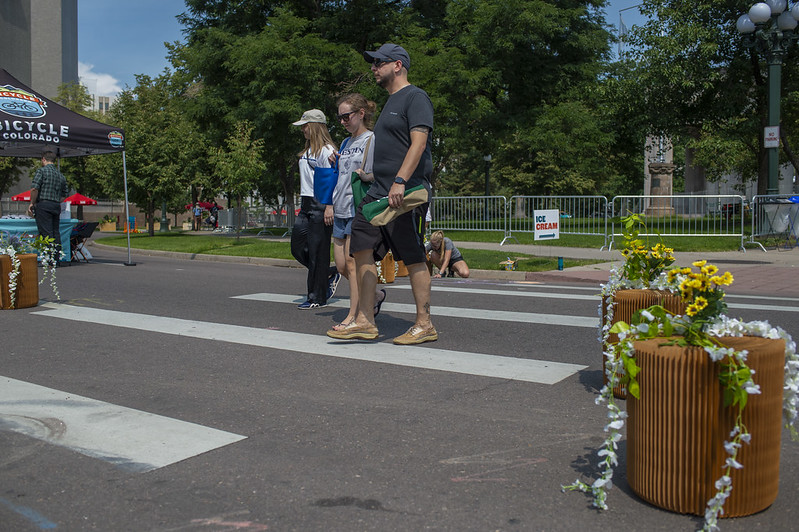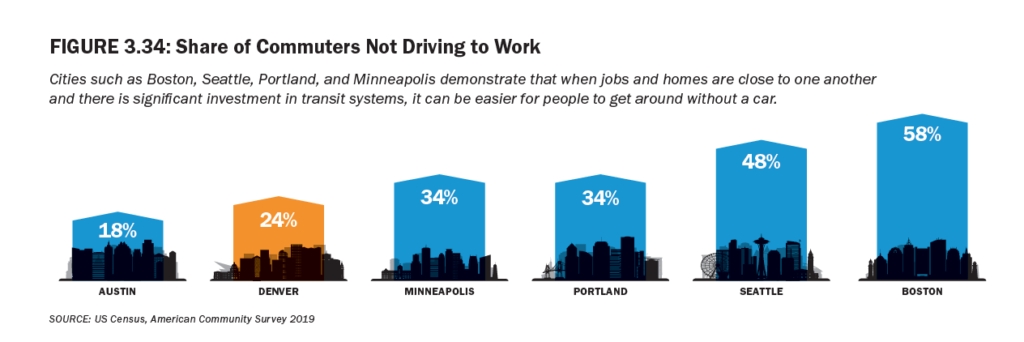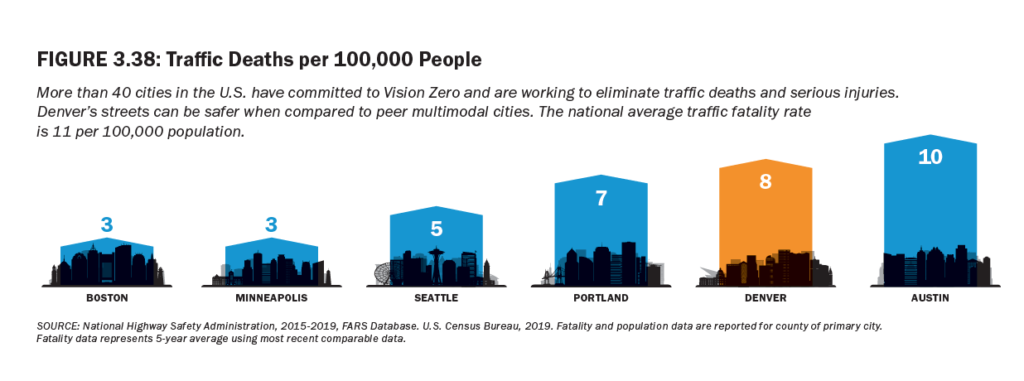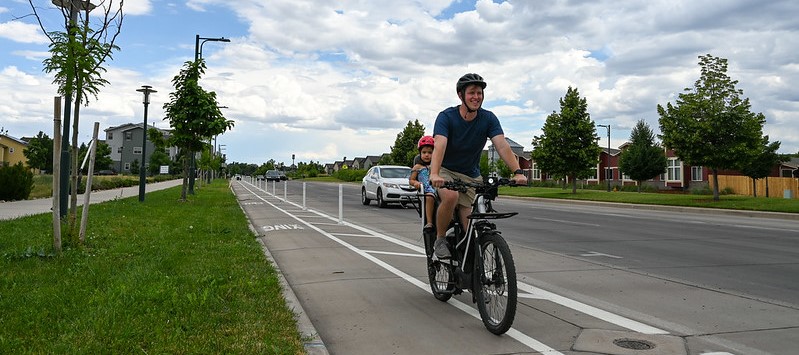If there’s one thing Denver is good at, it’s planning. Over the last several years, the City has developed a whole suite of plans for our transportation system (see sidebar). Now the City has released a draft 2050 Strategic Transportation Plan, called Denver Moves Everyone (DME), which aims to tie together all these disparate plans into a unified vision for “building a world class transportation system between now and 2050.”
Weigh in on Denver’s draft 2050 Strategic Transportation Plan by February 25
The City wants to hear from residents about their thoughts on the plan. We took a look—and found some forward-thinking ideas but at least one glaring missed opportunity. Check out our highlights below and send your comments to the City by February 25.
The Big Miss—A Critical Opportunity

Bus rapid transit (BRT) on five high-priority corridors is included in the list of short-term improvements [PDF] in the draft DME plan—to be completed by 2030, with already available funding! However, the proposal does not actually connect these BRT lines through the heart of central Denver to begin creating a truly gridded rapid transit network. Instead the plan suggests these connections may be implemented at a later time (closer to 2050, pending funding availability), and likely with a level of transit service somewhat less than full-blown BRT.
The DSP strongly encourages community members to comment and share that these BRT connections need to be added to the list of short-term improvements, not delayed to the future with uncertain funding and level of service.
More
The areas surrounding the intersections of Federal Boulevard, Colfax Avenue, and Speer Boulevard encompass 237 acres of land that is currently being redeveloped or will likely undergo significant redevelopment in the near future (Auraria Campus Master Plan Update, Stadium District Master Plan, The River Mile, Ball Arena Vision Plan, Colfax and Federal Interchange Transformation Study, Sun Valley Redevelopment, Burnham Yard Transportation Planning Study).
Failing to redesign the streets and connect the major transit improvements through this area in coordination with this redevelopment would be an enormous missed opportunity to catalyze progress towards our City’s safety, equity, and climate goals.
As we’ve been saying, building out a comprehensive BRT network throughout Denver will be essential for reducing our city’s unsustainable dependence on cars and addressing many of the urgent issues facing our community including equitably reducing air pollution and greenhouse gas emissions, saving lives, increasing affordability, and expanding access to opportunity for all residents.
What else you need to know

New Data on Current Conditions
We’ve been talking for years about the transportation-related challenges facing our city such as our ongoing dependence on driving as a primary mode (76% of commute trips), increasing traffic fatalities (82 people killed in 2022), and other poor health outcomes related to air pollution and sedentary lifestyles. The new DME plan provides some updated data that further illuminate these issues and point to known solutions, including comparisons to other cities that are leading the way.
More
Notably, cities like Seattle and Boston that have significantly invested in transit and promoted higher density development not only have greater shares of commuters not driving to work, but also lower rates of traffic deaths. This data is an important reminder of what’s possible, if we are willing to challenge the status quo here in Denver.


Notable New Strategies and Metrics
The draft DME plan reaffirms existing plans and strategies for improving transportation safety, reducing the environmental impacts of transportation, and prioritizing people walking, rolling, biking, and taking transit. It also includes some relatively new strategies that have not been discussed much in Denver before now. Here are a few that jumped out to us, and why we think they are important:
More
Develop an equitable Transportation Pricing Plan and associated policies while ensuring that it does not place additional burden on low-income and BIPOC travelers.
- Why it’s important: For decades governments have subsidized driving far more than other forms of transportation. Shifting how much individuals versus the community at large pays for things like parking and transit fares can help better align public subsidies with community values.
Support land-use development and policies that reduce the need for personal-vehicle trips by increasing density around centers and corridors and establishing parking maximums.
- Why it’s important. Low-density development, which often includes an excessive amount of off-street parking, makes walking, biking, and transit impractical and limits the number of people who can benefit from investments in new multimodal infrastructure.
Dedicate funding to be responsive and support ongoing implementation and refinement of community co-created mobility solutions and street improvements.
- Why it’s important: Residents often have great ideas for improving mobility in their own neighborhoods, but there is currently no clear path for moving these community-generated ideas forward.
Upgrade existing low-cost intersections and bikeway improvements with permanent materials upon evaluation to transfer successful pilot programs into permanent infrastructure.
- Why it’s important: Painted lines and lanes and plastic posts are important tools for quickly making urgently-needed safety improvements and testing out new street designs. However, they require a lot of maintenance and are not as robust as permanent improvements that should be installed relatively soon after confirming that the lower-cost treatments are achieving the intended safety outcomes.
Continue to improve ability to be nimble in project delivery by increasing contractor staff, improving contracting abilities to allow more work to be done in-house, and using public resources strategically.
- Why it’s important: While Denver is great at planning, it often falls short on implementation, with basic safety and multimodal improvement projects taking many years to build.
We were also pleased to see several new or strengthened metrics in the draft DME plan that provide clear benchmarks for measuring progress toward the plan’s larger goals, including:
- Transit travel times no more than 1.5 times longer than driving (currently transit takes 2.6 times as long, on average)
- 75% of households within high-frequent transit network (currently 25%)
- 100% of households within quarter mile of high comfort bike facility (currently 42%)
- 100% of sidewalks meeting standard (currently 2% of arterial streets, 8% of collector streets, and 5% of local streets)
Big Moves
Beyond the basic details of building out sidewalks, bike lanes, bus lanes, and other elements of a complete transportation system, the draft DME plan calls out several “Big Moves” that are “opportunities to be bold and rethink how our transportation system can be used to provide multiple benefits and meet future needs.” The plan organizes these moves into sections—in our analysis below, we’ve instead sorted them into themes relevant to DSP goals:
More
Theme: Blur the line between streets, parks, and public spaces for people
- Provide a park-like transportation experience with intensive green infrastructure on streets across Denver
- Build Shared Streets with aggressive traffic calming
- Create car-free zones, both temporary and permanent
- Increase capacity of Cherry Creek and Platte River Trails
Theme: Acknowledge that highways have caused a lot of harm to our communities, and the need to reduce their footprint in our city
- Construct caps (land bridges/coverings) over highways and major arterials
- Close select highway ramps to “reclaim space and calm traffic while creating new multimodal connections”
Theme: Technology is not just about cars
- Incentivize electric mobility “through an approach that centers and prioritizes shared mobility and multimodal transportation”
Theme: Let’s get serious about transit
- Accelerate implementation of BRT network
- Retrofit major arterials (large roads) along planned BRT routes to improve the pedestrian experience
- Designate Union Station as main hub for Front Range Passenger Rail
Putting a Price Tag on Success
For the first time ever, the DME plan estimates what it would actually cost to achieve the vision laid out in the plan. Not surprisingly, the estimated full cost of implementation by 2050—$800 M per year—vastly outstrips currently available funding—$170 M per year. The plan also clearly lays out what can actually be built by the year 2030 with the funding that is available, some of which we’ve highlighted below.
Highlights of major multimodal projects to be completed by 2030 with existing funding (see complete list here)
- Bike/pedestrian and multimodal underpasses – Alameda, Highline Canal, 38th, Huron, Weir Gulch, Sanderson Gulch, South Broadway, Derby Lateral Trail
- Bike/pedestrian and multimodal bridges – 48th, 47th, 44th/43rd, 38th, 31st, Bayaud
- Broadway bike and transit improvements – 6th Ave to 16th Ave
- Cherry Creek trail widening along 1st Ave – Downing to University
- Colfax/Federal Cloverleaf redesign
- Bus rapid transit on Colfax, Federal, Speer/Leetsdale, Colorado, 38th
More
The Denver Streets Partnership has been advocating for increased transportation funding since our inception, and we look forward to using these new cost estimates in the plan to move the conversation forward about potential new funding sources, and the best use of new funds when they become available. For example, while the most expensive item on the city’s wish list is new and upgraded traffic signals (an estimated $190 M per year), we believe funding for transit (an estimated $170 M per year) is far more important to meeting our community goals and should be the top priority for new fundraising.
Highlights of funding needs and targets
| Category | 2050 Target |
2030 Target (with existing funding) |
Annual need (for 2050 target) |
| Bike |
400 miles new bikeways 175 miles upgrades |
100 to 150 miles of new + upgrades | $30 M |
| Pedestrian |
300 miles new sidewalks 800 miles widened |
120 to 150 miles of new + widened* | $160 M |
| Transit |
100 miles of BRT 80 miles bus lane improvements 2,500 bus stop upgrades |
35 to 45 miles BRT 30 to 35 miles bus lane improvements 60 to 100 bus stop upgrades |
$170 M |
| Signals | > 4,000 signals replaced/updated | 250 to 300 signals replaced/updated | $190 M |
| Streetscape | 1,300 miles green infrastructure | 30 miles green infrastructure | $45 M |
*Note – these estimates do not reflect voter approval of Denver Deserves Sidewalks
There is a lot more to the draft DME plan than we had room to highlight here. You can read the whole plan and submit your comments at the Denver Moves Everyone website. Just be sure to weigh in by February 25!

